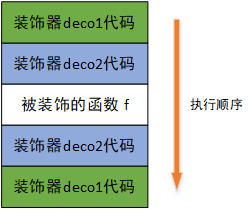装饰器
1. 函数装饰器
装饰器(fuctional decorators)可以定义成函数,来拓展原函数的功能,这个函数的特殊之处在于它的返回值也是一个函数,这个函数是内嵌“原”函数的函数。
本质上,函数装饰器就是一个返回函数的高阶函数。函数装饰器在被装饰函数定义好后立即执行。
1)最原始的装饰器
结合下面的例子。被装饰函数 f 即使没有被调用,但因为被 @deco 修饰,所以函数装饰器的代码已经运行了,即 deco 已经运行,deco内部嵌套的 wrapper
显然还没有运行,只是被定义了下,然后返回 wrapper 函数名变量。执行流程如下:
a. 先定义原函数 f。
b. 然后运行函数装饰器,即 f = deco(f)。
我们看到装饰器语法:@函数装饰器名,函数后面加上()才表示调用执行,故这个调用由解释器完成,它会自动执
行语句:deco(f),即以被装饰函数为参数来调用函数装饰器。如果我们这么修饰呢:@函数装饰器名(),即用 @deco() 代替 @deco,
那么按自动调用机制会执行:deco()(f),显然就会出错,除非让deco()返回一个带参数 func 的函数。
函数装饰器执行完后,被装饰函数名的引用就变了,变成函数装饰器的返回值 wrapper,即 f = deco(f) = wrapper。
def deco(f):
def wrapper():
print("decorate begin")
f()
print("decorate end")
return wrapper
@deco # 此行代码等同于,f = deco(f) = wrapper
def f():
print("call f")
f() # f = deco(f) = wrapper => f() = wrapper()
"""
decorate begin
call f
decorate end
"""
2)带有固定参数的装饰器
由1)中的解释,我们可以知道调用f时,实际调用的是wrapper,参数先通过wrapper的形参传入,然后wrapper内部再调用函数f,参数再间接传给f。
这种情况下,函数 f 和 wrapper 的参数个数和形式必须是一致的。
def deco(f):
def wrapper(a, b):
print("decorate begin")
f(a, b)
print("decorate end")
return wrapper
@deco
def f(a, b):
print("call f")
f(3, 4) # f = deco(f) = wrapper => f(3,4) = wrapper(3,4)
因为类的实例方法固定都会有一个参数,即self,所以如果将函数装饰器修饰类方法,那么作为装饰器嵌套的函数至少得带有一个参数。举个例子
def deco(f):
def wrapper(obj, s): # 第一个参数是实例对象
print("decorate begin")
f(obj, s)
print("decorate end")
return wrapper
class Bar:
@deco
def f(self, s): # 这里有两个参数,所以wrapper也得有相同的参数形式
print("call f")
print(s)
print("call f end")
x = Bar()
x.f("hello world") # 因为 f 是 x 的方法,所以会隐式传递 self 参数,x.f("hello world") => f(x, "hello world") => wrapper(x, "hello world")
3)带有可变参数的装饰器
如果可变参数语法不理解请先阅读另一篇博客 默认参数和可变参数
def deco(f):
def wrapper(*args, **kwargs): # args = (3,4), kwargs = {}
print("decorate begin")
f(*args, **kwargs) # args 和 kwargs 分别被解包后,再整体按顺序赋值给 f 的形参
print("decorate end")
return wrapper
@deco
def f(a, b):
print("call f")
f(3, 4)
4)使用多个装饰器,装饰一个函数
多个装饰器函数装饰的顺序是从里到外,也可以说由近到远,直接来看一个例子。
def deco01(f):
def wrapper(*args, **kwargs):
print("this is deco01")
f(*args, **kwargs)
print("deco01 end here")
return wrapper
def deco02(f):
def wrapper(*args, **kwargs):
print("this is deco02")
f(*args, **kwargs)
print("deco02 end here")
return wrapper
@deco01
@deco02
def f(a,b):
print("我是被装饰的函数")
f(3,4)
"""
output:
this is deco01
this is deco02
我是被装饰的函数
deco02 end here
deco01 end here
"""
按由近到远的原则,首先先装饰deco02,便得到下面的函数体:
print("this is deco02")
f(*args, **kwargs)
print("deco02 end here")
然后继续装饰deco01,在已经装饰了deco02的基础上,继续扩展代码,函数体就变成这样:
print("this is deco01")
print("this is deco02")
f(*args, **kwargs)
print("deco02 end here")
print("deco01 end here")
给个图,一目了然:

2. 类装饰器
代码逻辑很复杂时,不适合写在一个函数内,这时就可以使用类来实现。由函数装饰器可以知道,装饰器的执行其实就是:f = deco(f)。
把装饰器定义成类也是一样的,它与函数装饰器的区别如下:
1)deco 由函数名变成类名。
2)deco(f)含义不同,原先表示函数的执行,现在表示类实例化,即对象的定义。
3)函数装饰器执行完成后,f 重新引用的是装饰器的返回值; 而类装饰器实例化后,f 就引用了该实例。
所以这个类对象必须是可调用的,即f()能执行,就像 C++ 语法中的函数对象,即重载()运算符。python 中是通过实现__call__方法来达到这个目的。
实例变为可调用对象,与普通函数一致,执行的逻辑是 __call__ 函数内部逻辑。
class Bar:
def __call__(self, *args, **kwargs):
print(*args, **kwargs)
b = Bar() # 实例化
b("I am instance method.") # 等价于:b.__call__("I am instance method.")
类装饰器 __call__ 方法内的逻辑相当于函数装饰器内嵌的 wrapper 函数。举个例子,用类装饰器装饰普通函数:
class Deco:
def __init__(self, f):
self.func = f
def __call__(self):
print("Start __call__")
self.func()
print("End __call__ ")
@Deco # 函数定义完后会执行:hello = Deco(hello),hello 不再是函数引用,而是装饰器类对象
def hello():
print("Hello")
hello() # 其实是装饰器类对象的执行,hello() => Deco(hello)()
"""
Start __call__
Hello
End __call__
"""
如果把类装饰器用来装饰其它的类成员函数呢?参考用函数装饰器装饰类方法,装饰器内嵌的那个函数至少得存在一个参数来提供实例,因为类装饰器的
执行最终是调用 __call__ 函数,所以 __call__ 函数至少得存在两个参数,一个是 self,另一个提供给被装饰函数的 self。
class Deco:
def __init__(self, f):
self.func = f
def __call__(self, own): # 将 Test 实例对象传入,提供给 f
print("Start __call__")
self.func(own)
print("End __call__")
class Test:
@Deco # f = Deco(f)
def f(self): # 被装饰函数 f 有一个 self 参数
print("hello")
t = Test()
t.f(t) # t.f 被装饰后就是一个 object 而不是 method,所以没有传递 self 参数,t.f(t) = f(t) = Deco(f)(t) = __call__(Deco(f), t)
"""
Start __call__
hello
End __call__
"""
如果不想显示地传递这个实例参数,即 t.f(t) 改成 t.f(),该怎么做呢?可以实现一个__get__方法,即一个描述器,相关语法请先阅读:描述器。
from types import MethodType
class Deco:
def __init__(self, f):
self.func = f
def __call__(self, own):
print("Start __call__")
self.func(own)
print("End __call__")
def __get__(self, instance, owner):
if instance is None:
return self
else:
return MethodType(self, instance) # Deco 对象是可调用的,可以将它当作方法绑定 Test 对象
class Test:
@Deco # f = Deco(f)
def f(self):
print("hello")
t = Test()
t.f() # 因为 Deco 对象通过 MethodType 绑定到 Test 实例上了, 所以 f 此时是一个method,需要先传 self 参数
# 我们可以推知:t.f() => f(t) => Deco(f)(t) => __ call__(Deco(f), t)
__call__ 可以使用可变类型参数,增加普适性:
from types import MethodType
class Deco:
def __init__(self, f):
self.func = f
def __call__(self, *args, **kwargs):
print("Start __call__")
self.func(*args, **kwargs)
print("End __call__")
def __get__(self, instance, owner):
if instance is None:
return self
else:
return MethodType(self, instance)
class Test:
@Deco
def f(self):
print("hello")
t = Test()
t.f()
3. python内置的函数装饰器
有3种,分别是 @staticmethod、@classmethod 和 @property。
1)@staticmethod 修饰的方法是类静态方法:其跟成员方法的区别是没有 self 参数,并且可以在类不进行实例化的情况下调用,也可以在实例化的情况使用。
由于静态方法不包含 self 参数,所以它只能通过类名访问类成员,且只能访问静态成员,如 类名.属性名、类名.方法名。
class Test(object):
x = 0.1
@staticmethod
def f():
print("call static method.")
Test.x = 0.5
Test.f() # 静态方法无需实例化
Test().f() # 也可以实例化后调用
print(Test.x)
"""
output:
call static method.
call static method.
0.5
"""
2)@classmethod 修饰的方法是类方法:与实例方法的区别在于所接收的第一个参数不是 self (类实例的指针),而是cls(当前类的具体类型,有子类继承时,
就是子类类型)。类方法可以在类不进行实例化的情况下调用,也可以在实例化的情况使用。但静态方法的行为就是一个普通的全局函数,而类方法包含cls参
数,那 cls 参数有啥用呢?
解释:比如静态方法想要调用非静态的成员,必须知道类的具体类型,如在函数内部构造一个实例来调用,在存在派生类的代码中,知道具体类型还挺麻烦,
如果类名被修改,那代码就也得改。但 classmethod 方法却可以直接知道类的具体类型,即通过 cls 参数。看一个例子便清楚了:
class Test(object):
a = 123
def normalFoo(self):
print('call normalFoo.')
@staticmethod
def staticFoo():
print('call staticFoo.')
print(Test.a)
Test().normalFoo() # 访问非静态成员
@classmethod
def classFoo(cls):
print('call classFoo.')
print(Test.a)
cls().normalFoo() # 访问非静态成员
Test.staticFoo()
Test.classFoo()
3)property(把函数变属性):把一个方法变成属性调用,起到既能检查属性,还能用属性的方式来访问该属性。
访问属性的时候不需要是可调用的(即不用在后面加括号),所以装饰器没必要实现 __call__ 方法,它其实就是一个地地道道的描述器。
为什么需要它呢?我们在绑定属性时,如果我们直接把属性暴露出去,虽然写起来很简单,但是,没办法检查参数,导致可以把属性随便改:
class Student(object):
def __init__(self, score = 0):
self.score = score
s = Student()
s.score = 100
s.score = 200 # 分数为200明显不合理
s.score = -50 # 分数为负数也不合理
print(s.score)
对值进行约束的一个明显解决方案是隐藏属性 score(使其私有)并定义新的 getter 和 setter 接口来操作它。可以按照下面这样改,但这样
做存在的一个大问题:所有在其程序中实现我们前面的类的客户都必须修改他们的代码,将 s.score 修改为 s.getScore(),并且将像 s.score = val的
所有赋值语句修改为 s.setScore(val)。这种重构可能会给客户带来数十多万行代码的麻烦。
class Student(object):
def __init__(self, value=0):
self.setScore(value)
def getScore(self):
return self._score
def setScore(self, value):
if value < 0 or value > 100:
raise ValueError('score must between 0 ~ 100!')
self._score = value
s = Student()
s.setScore(100)
s.setScore(105) # 报错
s.setScore(-50) # 报错
print(s.getScore())
这时 property 就派上用场了。@property 真正强大的就是可以对属性增加约束来限制属性的定义。
class Student(object):
def __init__(self, value=0):
self._score = value
@property # 以需要定义的属性为方法名,如果没有@属性名.setter,则就是一个只读属性
def score(self):
return self._score
@score.setter # @property定义可访问属性的语法:以属性名为方法名,并在方法名上增加@属性名.setter
def score(self, value):
if value < 0 or value > 100:
raise ValueError('score must between 0 ~ 100!')
self._score = value
s = Student()
s.score = 100 #
s.score = 105 # 报错
s.score = -50 # 报错
print(s.score)


